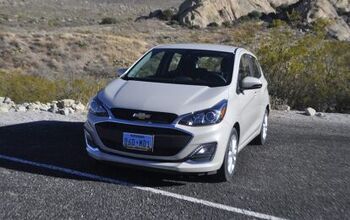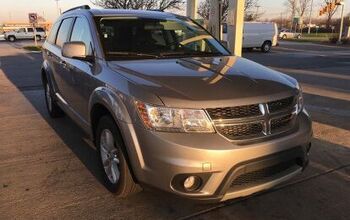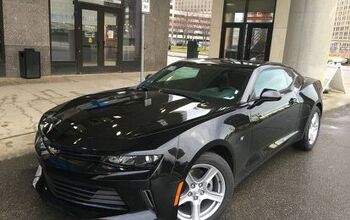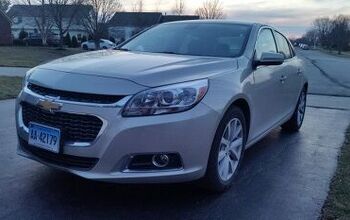2016 Chevrolet Spark Rental Review - The Real MVP

I don’t think I heard the term “MVP” used in software development until six or seven years ago. It doesn’t mean “Most Valuable Player,” nor does it mean either of the two rude but hilarious things from the “roasting” episode of Arliss, neither of which would be appropriate for a family website like TTAC. Rather, it means “Minimum Viable Product.”
The purpose of an MVP is to get your software out there in public usage so you can both obtain user feedback for future development and earn enough money to fund that future development. Google is well known for doing this: its original search page was the very definition of MVP compared to the monstrous multi-purpose interface that it is today.
You can make the argument that some non-software products out there are also MVPs. The toothbrush and toothpaste you get at a Holiday Inn Express when you’ve forgotten your own Black Series electric? That’s definitely a minimum viable product. When most young people furnish their first dorm room or apartment, they are definitely looking for their own MVP. When you’re traveling for business and they call closing time at the bar, you’re going to take a very open-minded view of what constitutes that minimum viable product for the evening.
What about cars? What’s the MVP of the modern automobile? Contrary to what some of the B&B believe, it’s not a 200,000-mile Corolla or Volvo. I’ve said it before and I’ll say it again: you gotta be rich to own a cheap car. Let’s look instead at what the minimum viable product might be for someone with very limited mechanical knowledge. Someone with no tools, no covered parking, no garage in which to service, no high-school buddy who now owns an import repair shop. In other words, a reliable vehicle with low cost of entry, low cost of operation, and a high likelihood of starting and running at all times.
What would that look like? What would it cost?
Three years ago, I drove the 2015 model-year predecessor to this car and was favorably impressed. Last month, I rented a 2016 Spark that was probably very close to being run through the auction lane. I was curious to see if the considerable number of changes had made Chevrolet’s little Korean city car more viable than before.
Let’s start by looking at the powertrain, which is now quite robust. It’s a 1.4-liter double-cam inline-four that turns out 98 horsepower, spinning a two-range CVT that has been programmed to act more like a conventional automatic transmission. The revs rise and fall as you drive, although the detail-oriented driver will notice that the rate of that rise and fall rarely corresponds with what’s actually happening on the road. With 13 more horsepower than the old car, the Spark now feels genuinely competent both on and off the freeway. No, it’s not a McLaren 675LT or even a big-bore Camry four-cylinder, but it’s never dangerously slow.
Considerable effort has been made to reduce the old noise, vibration, and harshness in the interior, which is now trimmed with a variety of fascinating-looking materials. This design philosophy, known to the English as “cheap and cheerful,” makes a lot of sense if you can do it right. Why not have brighter plastics and more interesting interior weaves? I mean, the all-black plastic/leather interior might be fine for a 1989 BMW M3, but when it’s done to a tight budget it tends to make for a really depressive experience.
As before, this is an adequate vehicle in which to carry four adults. You sit high and upright behind a mid-sized steering wheel that tilts a bit more to the horizontal than it would in most family sedans or even SUVs. The instrument panel has been revamped to convey a little extra seriousness and expense compared to the old “motorcycle cluster” in the previous model. Cargo room behind the seats is just enough for two sets of carry-on luggage.
There’s a lot of glass in the Spark, and for that reason alone I’m probably more fond of it than I should be. After spending time in modern pillboxes like the Camaro and many new-generation sedans, there’s something decidedly relaxing about being able to see out in all directions. The unfortunate side effect of that is that the Spark struggles a bit to keep the cabin cool in any serious sunlight. What would you expect from a minimum viable product? At least it has air conditioning and a pretty solid set of defrosters.
Handling is reassuring enough. Any attempt at a sudden lane change or an autocross-style maneuver will prompt an early and strident interaction from the stability control. After all, this is a tall vehicle with a high center of gravity. It’s not meant to be sporting in any way, shape, or form. Try a Sonic Turbo if you want a hot hatch from Daewoo. The wheels seem tiny and they are, at least by modern standards, mounting 185-width tires on 15-inch rims. Still, that’s enough overall diameter to prevent most potholes from seriously upsetting the car at speed. It’s still worth your time to look ahead, particularly in Northeastern cities like Chicago or Detroit.
The LT-level stereo is better than the stereo in the old one. Come to think of it, pretty much everything about this Spark is better than the old one, with the exception of fuel economy. Don’t expect 45 mpg or a 400-mile range and you’ll be fine. You are pushing a very tall silhouette with relatively little power. Even the CVT can’t make that work below a certain engine speed. Which is fine. Very few people will use this as a freeway commuter. The longest drive most of the owners will take will be to their first day of college.
This vehicle can be purchased pretty much unchanged in 2018 for $16,850 before discounts. That’s not a great deal, honestly. A Honda Fit would be slightly cheaper, and it’s more car. The real Spark bargain comes when you look at buying a slightly used one.
Turns out that Minimum Viable Products rarely generate much excitement away from the software game. $6,500 auction price for a 30,000-mile example that’s still under factory warranty? Even with some markup from a relatively friendly dealer, that’s maybe a $7,750 car. You couldn’t get a 2010 Corolla with more than twice that mileage from a dealer for the same money. If you look hard enough, you can even find one with a five-speed manual, which won’t turn this Spark into a Corvette Grand Sport but will remove one more complex mechanical system from the manifest.
At seven or eight grand, this 2016 Spark is highly recommended. It’s a comfortable, spacious, competent answer to that MVP question. No, it’s definitely not a car for enthusiasts. Unless, that is, you used the Spark as reliable daily transportation at low cost, thus allowing you to buy the garage queen or motorcycle you really want. In which case, the little Daewoo-Chevy would be that most improbable of things — the true MVP of your vehicular lineup.
[Images: Jack Baruth/The Truth About Cars]

More by Jack Baruth
Latest Car Reviews
Read moreLatest Product Reviews
Read moreRecent Comments
- ToolGuy 9 miles a day for 20 years. You didn't drive it, why should I? 😉
- Brian Uchida Laguna Seca, corkscrew, (drying track off in rental car prior to Superbike test session), at speed - turn 9 big Willow Springs racing a motorcycle,- at greater speed (but riding shotgun) - The Carrousel at Sears Point in a 1981 PA9 Osella 2 litre FIA racer with Eddie Lawson at the wheel! (apologies for not being brief!)
- Mister It wasn't helped any by the horrible fuel economy for what it was... something like 22mpg city, iirc.
- Lorenzo I shop for all-season tires that have good wet and dry pavement grip and use them year-round. Nothing works on black ice, and I stopped driving in snow long ago - I'll wait until the streets and highways are plowed, when all-seasons are good enough. After all, I don't live in Canada or deep in the snow zone.
- FormerFF I’m in Atlanta. The summers go on in April and come off in October. I have a Cayman that stays on summer tires year round and gets driven on winter days when the temperature gets above 45 F and it’s dry, which is usually at least once a week.





































Comments
Join the conversation
I'm a charter member of the "fix it yourself and drive more interesting cars" crowd, and I've read Jack's article about being rich to own a cheap car. +1, +100 One thing people often don't do is keep track of the maintenance costs, even if they're only buying parts. I've done this, but usually haven't bothered to look at the totals. Most expensive car to date? '08 Mini. But it died a year in, so not a lot of data. Second most expensive car? '03 BMW 325i. I did all the maintenance, but finally decided to get something else when I finally noticed it was costing between 2-$3k a year, in parts, to keep going. My point is that even when you do your own wrenching, there comes a point where you're just pouring money down a hole. But since it bleeds you a little at a time, sometimes you don't notice. I've told my kids to buy a car no more than three years old, and maintain the heck out of it. And to skip the German cars until they can afford something else to drive whilst working on them.
I bought one of these, new, last March, while Chevy was in the midst of a nationwide 20% off sale. As such, I can attest that the sticker bears, at best, a tenuous relationship to the actual selling price. I bought a base model (the true MVP, roll up windows and a touchscreen in the same car) which is about 2 grand cheaper than the high faluting 1LT car Baruth drove, and made it out the door for about $11 grand and some change, even with the taxes and bs dealer profit fees, and a payment under $200 per month, which made my wife happy.